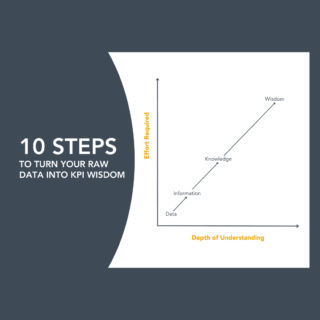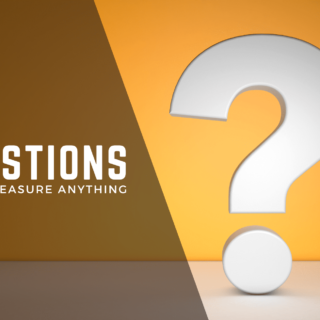Part 2 of 2
Nothing creates clarity for leaders and teams like agreeing on how to measure something. So why do so many people do everything they can to avoid it?
It’s because they are unable to recognize measurement’s true value proposition. The Leadership Institute states that a value proposition outlines, in as concrete and precise a way as possible, the value your product or service will create for the end-user. Here are 8 more value-drivers that make measurement such a differentiator of well-run organizations (and therefore worth the investment to improve).
Did you miss Part 1 of Measurement’s Value proposition? Find value-drivers #1-8 here
Value-driver #9: Measurement promotes consistency
A hole-in-one during a golf game is remarkable, but it does not guarantee you will win the round. The same can be said for performance in your organization. Outstanding performance is not about one great quarter, it is about consistent success over the long term that will make the difference to those whom your organization serves. And this consistency is the value that comes from measuring your systems well and accurately.
- Reflection: Can you think of a process within your organization that touches the people you serve (a customer of some sort) and how designing a new or better measure would drive more consistency (i.e. making the performance of the work process more predictable, or more accurate, or quicker) and would improve your user’s experience?
Value-driver #10: Measurement facilitates quantified feedback
Do you have workdays when you feel you are flying blind when trying to make decisions, like when you were a kid trying to pin the tail on a donkey, but you are blind-folded, and you don’t know which way to turn? Quality expert H. James Harrington says, “If measurement is the lock, then feedback over time is the key and without the interaction between the two, you cannot open the door to improvement”.
- Reflection: Can you think of a strategic goal that you are currently spending significant time and money on trying to improve? Could you ask some of the people tasked with achieving it how they feel about the quality of the feedback they are receiving from the measurement system. How is it helping them make decisions?
Value-driver #11: Measurement increases alignment across an organization
You’ve completed your strategy, now comes the harder part – trying to align your people and resources to the change needed to achieve this new and better future. Too often a “good job of alignment” results in independent functional silos focusing on maximizing only their own measures of success. However, true value from a measurement system is not driven by siloed departments operating independently of one another. The sweet-spot is when self-interest intersects with organizational-interest, where teams see the integral relationships between the work they do and how it intersects with what the organization wants to achieve. Measurement encourages teams to explore how the work they do impacts the work getting done across the organization.
- Reflection: Consider where you are seeing self-interested behaviour within your organization today. What do you think is causing employees to act only in their own, or their own department’s, self-interest? How might the approach to measurement and rewards within silos be playing a part?
Value-driver #12: Measurement improves decision-making
Dr. Paul Nutt, author of Why Decisions Fail, contends that two out of three managers use “failure-prone” decision-making practices, with as many as 50% of all managerial decisions failing. So, what’s going on? One of the major reasons for failure-prone decisions is the over-reliance on intuition (an individual’s combination of experience, opinion, mythology, power politics, and probability). All of which are highly susceptible to bias and personal blind spots. In the absence of trustworthy data, anyone’s opinion is as good (or as poor) as anyone else’s, and too often, the person with the highest authority wins. Intuition is good, but by itself, it is not good enough. The value of measurement done well is that it increases a leader’s decision-making batting average. Because as the proverb goes “One accurate measurement is worth a thousand opinions.”
- Reflection: How are improvement decisions made in your organization? Is the use of an individual’s intuition a common approach? Or, if they are using data, is it usually within limited comparisons (such as only two points of data)? Do you know a leader who wants to improve how they make decisions by having evidence they can trust to augment their intuition when making workplace decisions?
Value-driver #13: Measurement improves problem-solving
When employees detect problems in their workplace, often they don’t realize that they are only experiencing the symptoms of a much deeper root cause. Peter Sengue cautions to “beware the symptomatic solution” because you can’t resolve a problem by simply removing the symptom. Consider a persistent headache. When you take a painkiller, it temporarily removes the symptom, but the root cause is ignored. It is the same in the workplace; when a serious-enough problem is identified, the root causes need to be diagnosed. The value delivered by a disciplined measurement with validated data, is that problems become much easier to discover, prioritize and solve.
- Reflection: Is there a persistent problem occurring in your workplace where you keep treating the symptoms, but the problem never seems to be completely solved? How could measuring the process where this problem is occurring help fix it for good?
Value-driver #14: Measurement provides early-warning signals
“Why didn’t we see this coming?” is a question often asked by leaders once a problem reaches a crisis level. So, how can measurement help? To detect changes in performance early enough to address them, organizations need to calibrate their measurement system for both key internal and external environments. For example, leaders who fail to systematically monitor over time their customers, users, or stakeholders, may fail to detect early change and, as a result, find out too late that their organization is slipping into crisis.
- Reflection: What is less expensive over the long run: investing in building the skills, capabilities and processes needed to do measurement well so you can get early warning signs, or the costs of managing your organization’s reputation when significant losses occur, or launching a major structural overhaul and re-org, or driving funding recovery programs?
Value-driver #15: Measurement provides a deeper understanding of just about anything
Just ask any Olympic athlete. They will agree that understanding the performance of where we are today, relative to where we were in the past and where we hope to be in the future is measurement’s fundamental purpose. The value that measurement provides is captured in the quote “If you can’t measure something, you can’t understand it. If you can’t understand it, you can’t control it. If you can’t control it, you can’t improve it.”
- Reflection: Where is your organization currently investing lots of time and money to improve an important process, but you don’t know what is working and what is not? Could having the conversation of how you might measure bring a much deeper understanding of what might be going on?
Value-driver #16: Measurement motivates
Pride in accomplishment, initiative to improve, and healthy competition encourage powerful, intrinsic motivational forces that come naturally from measuring well and can help break the inertia brought on by the fear of change. However, despite the enormous potential to motivate intrinsically, measurement is often linked too closely to rewards (and punishment) and causes targets and measures to lose their value and instead drive dysfunction and undesired behaviors.
- Reflection: Have you noticed where rewards are driving undesirable behaviours within your organization (yet they were put in place to do the opposite)? What could you do to bring this dysfunction to the attention of a leader and explore how the organization could avoid it?
Measurement when done well, when socialized appropriately, has the potential to be a positive force in your organization and deliver greater value than any other management system. Are you ready to invest in what it takes to do measurement well?
(Special thanks goes to Dean R. Spitzer, PhD, Author of Transforming Performance Measurement, 2007 for his generosity of knowledge and thought within the measurement space and with his permissions with Adura Strategy.)



